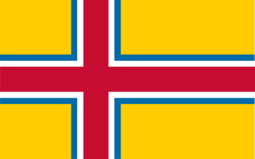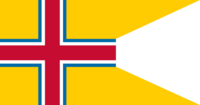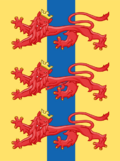Flag of Sjealand: Difference between revisions
old>Sjealand |
No edit summary |
||
| (One intermediate revision by one other user not shown) | |||
| Line 110: | Line 110: | ||
[[Category:Sjealand]] | [[Category:Sjealand]] | ||
[[Category:Midgard]] | |||
[[Category:Aldinea]] | |||
Latest revision as of 17:50, 17 November 2019
 | |
| Use | Civil flag and ensign |
|---|---|
| Proportion | 5:8 |
| Adopted | December 21, 1194 |
| Design | A yellow field with a three Sjealandic Crosses that extend to the edges of the flag; each cross is twice the height and width of the previous; the vertical part of the crosses are shifted to the hoist side. |
 Variant flag of Sjealand | |
| Use | State flag, state and naval ensign |
| Proportion | 1:2 |
| Adopted | Dates back to the early-1600s. Described in law on 4 april, 1671. |
| Design | A yellow field with a three Sjealandic Crosses that extend to the edges of the flag; each cross is twice the height and width of the previous; the vertical part of the crosses are shifted to the hoist side. Overall ratio, including the tails, is 1:2 |
The Flag of Sjealand (Tynic: Baldur Tynic pronunciation: [/ˈpal.tʊɹ/] is yellow with blue white and red Sjealandic Crosses that extend to the edges of the flag; the vertical part of the crosses are shifted to the hoist side.
Reportedly the use of a cross-flag or as it is called in Sjealand, a Sword-flag, dates back to before the Sjealandian Unification Wars and has traditionally been used to represent the warrior culture of several local petty kings, thus signifying their willingness to use force. However the first actual reported use of the flag was in 1194 as a personal standard of Archking Ragnvald II of Sjealand in his battles against Swastrian Trinitarians. According to 12th century Sjealandian skjald Ansur Tusindsang the banner came as a sign from Stórrheðrinn, the central diety of Ríkr Átrunaðr, in the form of a blood-soaked sword laid upon the Archkings golden cape, with Godes preaching that the use of this sword and this standard would lead the Sjealanders to victory, which they reportedly achieved.
Contemporary vexillologist and historians suggest the banner came about as a a heraldic device, the cross simply dividing a heraldic flag into 4 subsections, but with the Archkings slowly removing the heraldic devices to better differentiate their standards from those of the Swastrians, a tactic that hardly worked as the Swastrians in the end began copying the Sjealandic flag tradition. Today, use of the flag is regulated by a set of rules called Flagkoden, and the swallow-tailed version is only allowed to be flown by select individuals, organisations and companies. The flag is the oldest flag in Nordania, and the second oldest in all of Esquarium, being only beaten by the flag of Senria
Description
History
First appearance
North Sea Realm
Early military banners
Maritime flags
National flag
Origin legend
Variants and Other Flags of the Sjealandic Realm
Historical Flags
National flags and ensigns
| Flag | Date | Use | Description |
|---|---|---|---|
 |
Ca. 600-1000 | Standard of the Kingdom of Skargasdal, a predecessor to Sjealand. Illustrations from Sjealandic, Swastrian and Jorvish manuscripts shows this flag in use by Sjealandic armies and navies until the 1000's | . |
Sjealandic possessions and former territories
| Flag | Date | Use | Description |
|---|---|---|---|
 |
Ca. 1532-1691 | Naval flag of the Kingdom of Ambrose under Lyksborg rule. Earliest know use is in the 1530's and the flag was also flown as a battle-flag by loyalists during the Ambrosian War of Liberation. | Combination of the Sjealandic flag and the flag of the Kingdom of Ambrose. |
| 1578 —1867 | Official flag of the Sjealandic Viceroy of Goldhavn in Hethland. By Royal Decree it became the Viceroyality's official flag in 1578 along with several others and remained in use until the Great War of the North | Blue and white Sjealandic cross on a yellow field. | |
| 1578 —1867 | Official flag of the Sjealandic Viceroy of the Gunneyjar archipelago in Hethland. By Royal Decree it became the Viceroyality's official flag in 1578 along with several others and remained in use until the Great War of the North | Blue and yellow Sjealandic cross on a white field. | |
| 1578 —1867 | Official flag of the Sjealandic Viceroy of Salstæd in Hethland. By Royal Decree it became the Viceroyality's official flag in 1578 along with several others and remained in use until the Great War of the North | Yellow and black Sjealandic cross on a red field. | |
| 1578 —1867 | Official flag of the Sjealandic Viceroy of Isaresmynd in Hethland. By Royal Decree it became the Viceroyality's official flag in 1578 along with several others and remained in use until the Great War of the North | White and blue Sjealandic cross on a green field. | |
| 1578 —1867 | Official flag of the Sjealandic Viceroy of Langedyn in Hethland. By Royal Decree it became the Viceroyality's official flag in 1578 along with several others and remained in use until the Great War of the North | White and black Sjealandic cross on a blue field. | |
| 1631—1867 | Official flag of the Admiral of Hedsadal, the Military Governor from the Royal Sjealandic Navy in the Sjealandic military territory in modern day north-western Eisarndal. | White and black Sjealandic cross on a green field. | |
 |
1621—1867 | Official flag of the Sjealandic Viceroy of Vestmannaland. Eventually became the flag of the Viceroyality of Vestmannaland and was in use until the Great War of the North | Swallow-tailed white and orange Sjealandic cross on a green field. |
 |
1537—1867 | Flag of Hvidland under Sjealandic rule. Officially the flag of the Duke of Hvidland, but upon decree of the Court it became the official flag of Hvidland in 1859. A variant is still in use in Swastrian-administered Hvidland | |
| 1821 —1926 | Flag of Sjealandic Ankoren, the Sjealandic possessions in the modern day Union of Nautasian Islamic Republic. The flag was granted in 1821 at the request of the governor of Kara Baba | ||
| 1520—1691 | Flag of Sjealandic Pekamlu | ||
| 1401—1640 | Flag of the Sjealandic Grand Duchy of Hageborg a Sjealandic feudal possession within the Kingdom of Hethland | ||
 |
1180—1882 | Flag of Tuthinan company a Sjealandic trade company operating in Borea and also the flag used in all Sjealandic trade-posts in East Borea |
Royal
| Flag | Date | Use | Description |
|---|---|---|---|
 |
1581-1829 1870—present |
Royal Standard of Sjealand, used by The Monarchy. The flag was codified in the 1500's and for a time also served as the official flag of the North Sea Realm | Blue field with the Sjealandic sun flanked by two eagles |
| 1829-1870 | Royal Standard of Sjealand, from the introduction of the Sjealandic constitution till 1870, a few years after the disastrous defeat in the Great War of the North, after which the Court launched a royal coup and re-introduced the old and current Royal Standard | Blue field with the Sjealandic sun | |
| 1526-present | Royal pennant of Sjealand | Blue field with the Sjealandic sun and a red-gold bicolour |
Governmental and Military
| Flag | Date | Use | Description |
|---|---|---|---|
 |
1671—present | The state flag of Sjealand is used as the War-flag of the Sjealandic Defence and is the Naval jack of the Royal Sjealandic Navy | Swallow-tail version of the Sjealandic Flag. |
 |
1576—present | Naval Ensign of the Royal Sjealandic Navy | Blue swallowtail with the Sjealandic sun |
| 1720—present | Pennant of the Royal Sjealandic Navy | Blue field with the Sjealandic sun and a blue Sjealandic cross on a golden field. | |
 |
1215—present | Religious and battle-flag of the Sjealandic Monarch. Symbolizes his or hers position as the Caretaker of Sjealand. | Blue gonfalon with a sun and several sun rays |
 |
1103—present | Standard of the Godspeaker and the entire faith of Ríkr Átrunaðr, Sjealands state religion | Gonfalon with a White Sjealandic sun, symbolizing God, on a red field, symbolizing mans impurity and decorated with small golden stars, symbolizing the Monarchy and the lesser deities. |